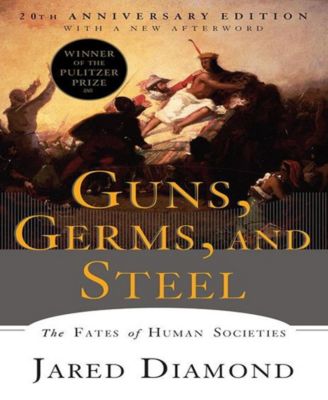Guns, Germs, and Steel- The Fates of Human Societies by Jared Diamond
Product details
Web ID: 5111304Informative Yet Repetitive Text on Human Societies
If Guns, Germs, and Steel, were a 400+ page essay, Diamond offers us his thesis in the Prologue: “History followed different courses for different peoples because of differences among peoples' environments, not because of biological differences among peoples themselves.” That sentence is a fitting summary for this tome that is as much about science as it is about history, delving into biology, archaeology, linguistics, geography, agriculture, metallurgy, and more to tell a story about human history, how we evolved into societies, and how we emerged differently across the continents. If you have ever wondered why one country struggles while another thrives, or why whites conquered tribes of Native peoples rather than vice versa, or even why some resources were harvested from lands and others imported, this book gives you plenty to chew on and digest. Diamond makes a solid argument here, setting his book up in parts like separate pieces of evidence while repeatedly bringing those pieces together to support his aforementioned thesis. For historians, it can be a fascinating, if repetitive read; Diamond often repeats his points throughout the book, when some brevity may have aided its readability. For example, over 100 pages of the book are dedicated to food production (geographic differences, plant domestication, and the spread of production). This is absolutely relevant to the course of human history and the rise of civilizations, and it is fascinating to read through the first time around; however, Diamond repeatedly brings up food production throughout the rest of the book in the context of one tribe, civilization, or another, and goes as in-depth about all its details as he would need to if the reader hadn't already consumed so much of this knowledge. It's as if Diamond doesn't trust the reader to have been paying attention, so every time he touches upon a subject he rehashes most details like a broken record. As stated earlier, even when reading this from a standpoint of intense interest, this method of repetition became stale very quickly. That brings me to my greatest negative of the book: readability. If you are going into this to read it cover to cover, like I did, it may test your patience. Diamond seems to be scatterbrained as a writer, dedicating entire chapters to one subject or another while continually rehashing previous points as if he weren't done speaking on them. For the average reader, this book may come across as dry or even boring. This is a lot of information to digest, and Diamond's tendency to repeat himself convinces the eye to wander or skim the text. Hurting the book's chances to be digested are the enormous amount of subjects it tries to tackle (all the subjects of history and science I listed above). If you aren't in the least interested in botany, for example, you may struggle to get through many of the chapters about food production, which focus on plant growth related to geography and domestication. The unfortunate thing about this is that it is all relevant, and Diamond tries his best with the subject matter he focuses on; however, the book is hard to define, and thus, despite its good reception it may struggle to find an interested audience. In saying that, however, I did immensely enjoy the book, though I had to digest it a bit at a time, particularly toward the end as the repetition became more and more intense (even the Epilogue essentially serves as a long repetitive summary for the entire book). Diamond is extremely wordy, but he is also clearly passionate about sharing his findings with the reader. I believe Diamond presented a solid argument with his thesis and fully supported it with this book; it was his prose and delivery method that needs work. In summary, Jared Diamond has a fascinating read on the development of human societies in Guns, Germs, and Steel, but I can only recommend this book to historians, scientists, researchers, or readers who are particularly historically or scientifically inclined. Other readers will want to give this one a skip. Guns, Germs, and Steel is exhausting, but also fascinating and impressively put together, and I give it a 62/100.
Recommends this product
Customer review from barnesandnoble.com

